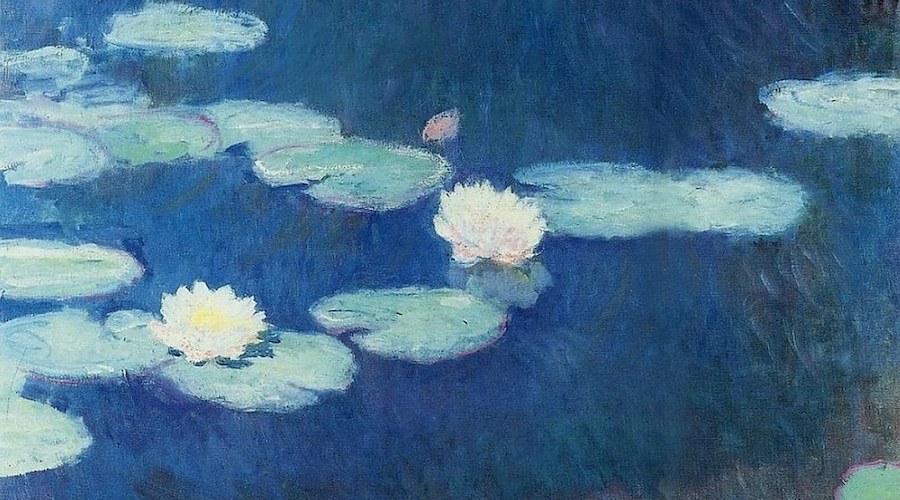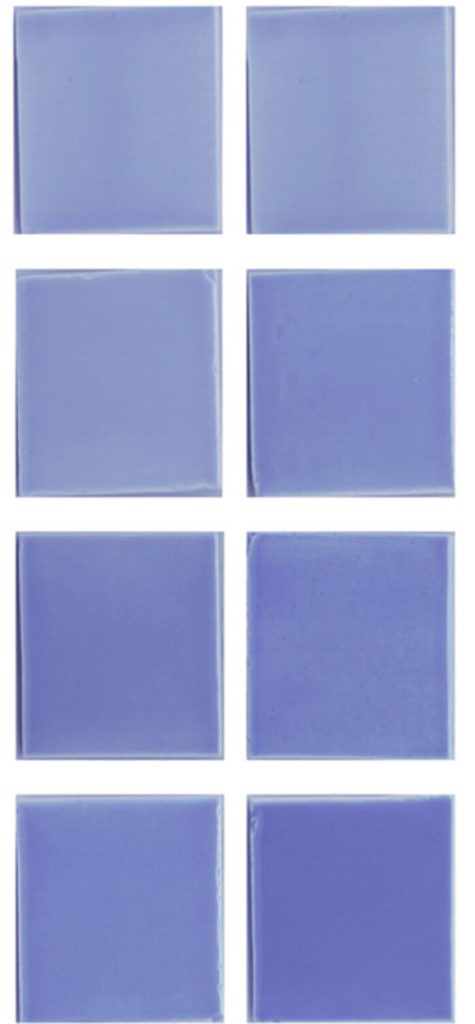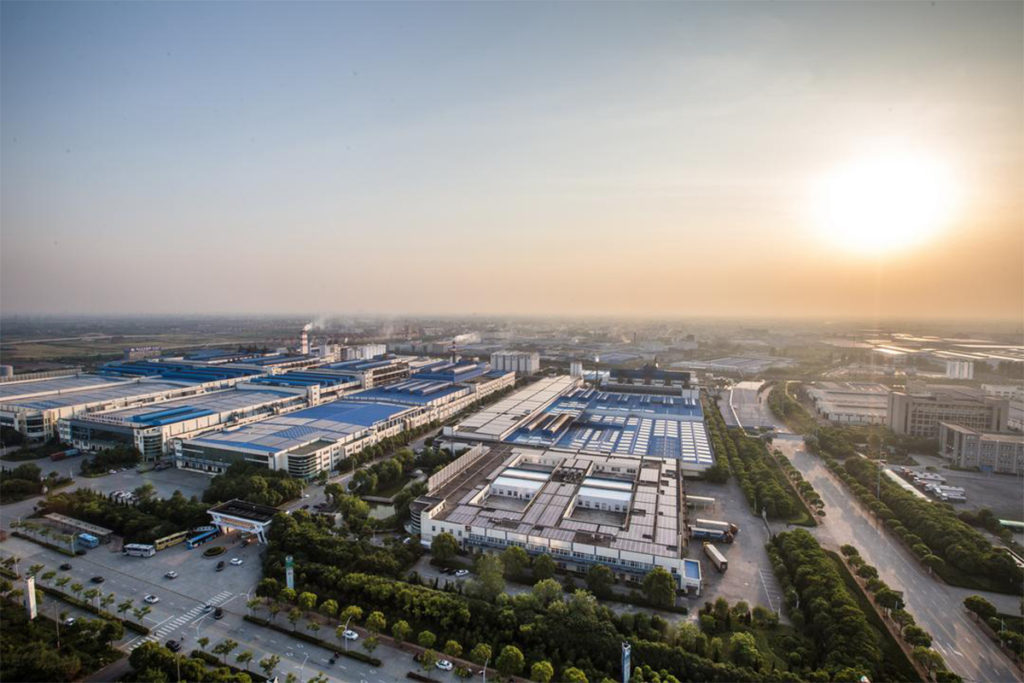Staff Writer | March 3, 2024

Claude Monet’s Water Lilies from his private collection.
(Image in the public domain retrieved from Wikimedia Commons.)
Researchers have discovered a new cobalt-doped barium aluminosilicate colourant that withstands the high temperatures found in a kiln and provides a bright colour to glazed tiles.

In a paper published in the journal ACS Applied Optical Materials, the scientists point out that many brilliant blue pigments—like those in antique Chinese porcelain or works by Claude Monet—make use of cobalt-based compounds, including the famous “cobalt blue.”
In mineral form, the metal has high chemical and thermal stability, and those properties make cobalt aluminate one of the only pigments suitable for high-temperature applications, including pottery glazes.
Researchers have discovered a new cobalt-doped barium aluminosilicate colourant that withstands the high temperatures found in a kiln and provides a bright colour to glazed tiles.

In a paper published in the journal ACS Applied Optical Materials, the scientists point out that many brilliant blue pigments—like those in antique Chinese porcelain or works by Claude Monet—make use of cobalt-based compounds, including the famous “cobalt blue.”
In mineral form, the metal has high chemical and thermal stability, and those properties make cobalt aluminate one of the only pigments suitable for high-temperature applications, including pottery glazes.

Tiles produced bright colors when glazed with a new blue pigment (right row) or an acidified version of the pigment powder (left row). (Image by adapted from ACS Applied Optical Materials.)
Today, cobalt is used in lithium-ion batteries, and demand for the metal ore will likely increase as the need for battery power grows. As a result, scientists, including Peng Jiang and colleagues, are searching for alternative pigments that require fewer cobalt ions and still maintain a bright blue hue.
The team based their new pigment on a barium feldspar mineral (BaAl2Si2O8), which also features high temperature and chemical stability. Compounds containing barium, aluminum, silicon and cobalt were ground together, pressed into a sheet, then heated to above 2550 degrees Fahrenheit to form the pigment.
Then, the researchers mixed the powder into a ceramic glaze, sprayed it onto tiles, and fired them to produce glazed pieces of pottery.
The pigment was stable at temperatures up to 3200 degrees—well above the typical firing temperature of a pottery kiln—and only experienced slight colour changes when exposed to either acidic or alkaline solutions, demonstrating the compound’s stability.
Tiles sprayed with the pigmented glaze maintained a smooth, bright surface that deepened in colour as the cobalt concentration in the pigment increased.
The researchers say this new powder substantially reduces the amount of cobalt needed, resulting in a cheaper, easier-to-produce blue ceramic pigment.
Today, cobalt is used in lithium-ion batteries, and demand for the metal ore will likely increase as the need for battery power grows. As a result, scientists, including Peng Jiang and colleagues, are searching for alternative pigments that require fewer cobalt ions and still maintain a bright blue hue.
The team based their new pigment on a barium feldspar mineral (BaAl2Si2O8), which also features high temperature and chemical stability. Compounds containing barium, aluminum, silicon and cobalt were ground together, pressed into a sheet, then heated to above 2550 degrees Fahrenheit to form the pigment.
Then, the researchers mixed the powder into a ceramic glaze, sprayed it onto tiles, and fired them to produce glazed pieces of pottery.
The pigment was stable at temperatures up to 3200 degrees—well above the typical firing temperature of a pottery kiln—and only experienced slight colour changes when exposed to either acidic or alkaline solutions, demonstrating the compound’s stability.
Tiles sprayed with the pigmented glaze maintained a smooth, bright surface that deepened in colour as the cobalt concentration in the pigment increased.
The researchers say this new powder substantially reduces the amount of cobalt needed, resulting in a cheaper, easier-to-produce blue ceramic pigment.
Huayou Cobalt chief proposes battery material policy to tackle overcapacity
Reuters | March 4, 2024 |

Credit: Huayou Cobalt
China should adopt measures to tackle overcapacity in the lithium battery material industry, the chairman of Zhejiang Huayou Cobalt proposed ahead of the country’s annual parliamentary meeting, state media reported on Monday.

Overinvestment led to “severe overcapacity” in the last year, said Chen Xuehua, who is a delegate to China’s National People’s Congress (NPC), which gathers in Beijing from Tuesday.
Chen cited “significant declines” in industry capacity utilisation.
“Some companies’ operations are facing great difficulties, there are suspended operations, falling prices, idled equipment and staff layoffs,” Chen said, according to a report by Shanghai Securities News.
China’s lithium iron phosphate capacity will reach 5.75 million metric tons in 2025, while global demand for the cathode material widely used in batteries is pegged at about 2.67 million tons that year, he added, citing industry data.
Chen, whose company is a major producer of battery materials nickel and cobalt, proposed that the government publish timely industry information, establish an alerting system to flag mismatch of resources, capacity and demand, and provide guidance on investment and development.
Regulations in Europe and the United States have made it harder to source waste batteries and recycled raw materials, posing challenges to China’s leading role in the lithium battery chain, said Chen, whose company recycles used batteries.
China should encourage more imports of used battery materials, especially hydroxide intermediate made from waste lithium batteries, including by lowering tariffs, he said.
China bans imports of used lithium batteries and black mass, the shredded material which comes from used batteries, which can include lithium, cobalt and nickel. These metals can then be extracted and used to make new batteries.
(By Siyi Liu and Emily Chow; Editing by Tony Munroe and Emelia Sithole-Matarise)
Reuters | March 4, 2024 |

Credit: Huayou Cobalt
China should adopt measures to tackle overcapacity in the lithium battery material industry, the chairman of Zhejiang Huayou Cobalt proposed ahead of the country’s annual parliamentary meeting, state media reported on Monday.

Overinvestment led to “severe overcapacity” in the last year, said Chen Xuehua, who is a delegate to China’s National People’s Congress (NPC), which gathers in Beijing from Tuesday.
Chen cited “significant declines” in industry capacity utilisation.
“Some companies’ operations are facing great difficulties, there are suspended operations, falling prices, idled equipment and staff layoffs,” Chen said, according to a report by Shanghai Securities News.
China’s lithium iron phosphate capacity will reach 5.75 million metric tons in 2025, while global demand for the cathode material widely used in batteries is pegged at about 2.67 million tons that year, he added, citing industry data.
Chen, whose company is a major producer of battery materials nickel and cobalt, proposed that the government publish timely industry information, establish an alerting system to flag mismatch of resources, capacity and demand, and provide guidance on investment and development.
Regulations in Europe and the United States have made it harder to source waste batteries and recycled raw materials, posing challenges to China’s leading role in the lithium battery chain, said Chen, whose company recycles used batteries.
China should encourage more imports of used battery materials, especially hydroxide intermediate made from waste lithium batteries, including by lowering tariffs, he said.
China bans imports of used lithium batteries and black mass, the shredded material which comes from used batteries, which can include lithium, cobalt and nickel. These metals can then be extracted and used to make new batteries.
(By Siyi Liu and Emily Chow; Editing by Tony Munroe and Emelia Sithole-Matarise)
No comments:
Post a Comment